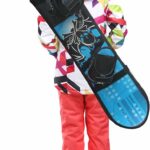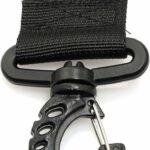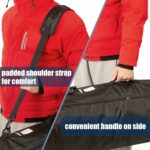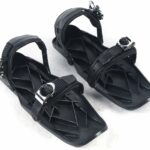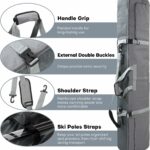Picture this: it’s a chilly morning, you’re on your way, the world around you gleaming with a fresh coat of snow. Suddenly, you feel an itch, an urge to grab your snowboard and fly downhill, doesn’t matter if you’re not at a ski resort. You might then ponder, can you snowboard anywhere? This guide is here to satiate your curiosity and shed some light on where and how to snowboard, regardless of whether you’re among powdery peaks or just a hilly suburban neighborhood.
Understanding Snowboarding Basics
Snowboarding, it’s quite an exciting sport, isn’t it? But before you strap your feet onto that board and catch your first wave of snow, there are a few basics you need to understand to fully enjoy this thrilling sport. Snowboarding is a winter sport that will have you riding down a snow-covered slope while standing on a snowboard. This board is attached to your feet just like a surfboard to a surfer’s feet. The operational principle here is slanting and sliding your way down the hill.
Different Styles of Snowboarding
When it comes to snowboarding, there is not one size fits all approach. There are varied styles of snowboarding including freestyle, freeriding, and alpine snowboarding. Freestyle is the most popular amongst snowboarders, often seen at parks with various obstacles such as rails and jumps to maneuver. Freeriding is more about exploring and enjoying the mountain terrain. Alpine snowboarding is where getting down the mountain as fast as possible is the priority, often involving carved turns and rapid descents.
Equipment Needed for Snowboarding
Without the right gear, even the most adept snowboarders will struggle. Key snowboarding equipment includes snowboards, boots, snowboard bindings, and snowboard-specific clothing like jackets, pants, gloves, and helmets. Snowboard boots and bindings are crucial as they connect you to your board and transfer your physical movements to control the board. Keeping yourself well-dressed is also essential to protect you from the harsh winter conditions.
Locations Ideal for Snowboarding
The world is full of amazing locations where you can snowboard. From the powder-filled mountains in Japan, the challenging terrains in the Alps, to the popular resorts in North America.
Mountain Resorts
Mountain resorts are arguably some of the best places to snowboard. These resorts often feature groomed trails, snow-generating capabilities, and convenient facilities such as rental shops and dining options.
Snow Parks
Snow parks provide a more structured environment for snowboarding, often consisting of human-made features and snowboarding obstacles like jumps, rails, and half-pipes.
Urban Environments
Urban snowboarding, although not for the timid, offers unique challenges such as staircases, railings, and even rooftops. It’s not the traditional style but is rapidly gaining popularity.
Backcountry Areas
Backcountry areas offer a remote and untamed environment for those seeking solitude amongst the snowy peaks. However, these areas also pose significant dangers, particularly avalanches, so extra caution and preparations are required.
Physical Requirements for Snowboarding
While snowboarding is an exciting activity, it does require a certain degree of physical fitness and skills.
Essential Fitness Levels
Strength, endurance, flexibility, and balance are all vital in snowboarding. Regular fitness activities like running, yoga, weightlifting can help keep you in excellent physical condition for this sport.
Skills Required for Snowboarding
Snowboarding skills such as edge control, weight distribution, and how to safely fall are crucial in terms of making turns, stopping, and avoiding injury.
Risk Factors Involved in Snowboarding
As with any sport, snowboarding has inherent risk factors including potential falls, collision with obstacles, and exposure to hazards in the snow.
Proper Weather and Snow Conditions
When it comes to snowboarding, the right weather and snow conditions can make or break your experience.
Ideal Weather Conditions for Snowboarding
Bright, sunny days with calm winds and soft snow offer the best conditions. The vision is clear and the snow is easier to ride on.
Understanding Snow Quality and Its Impact on Snowboarding
The quality and condition of the snow directly impact your ride. Powder snow is ideal as it is soft, fluffy, and provides a smooth ride. Conversely, icy or slushy snow can pose additional challenges.
Safety Measures During Severe Weather Conditions
In severe weather conditions, visibility can be significantly reduced and the slopes can become dangerous. It’s important to heed weather warnings, stay within the marked areas, and always let somebody know your plans for the day.
Regulation and Permission
While snowboarding is a fun activity, you should always understand legalities and permissions associated with it.
Legal Restrictions for Snowboarding
Some places have specific restrictions for snowboarding due to environmental concerns or safety issues. Always verify local laws before heading out.
Permits Required for Snowboarding in Different Areas
In some places, you may need a permit or pass to snowboard. Make sure to check with local authorities or resort offices about requirements.
Respect for Private Property and Protected Areas
Snowboarding should always be done in designated areas. Trespassing onto private land or into protected natural reserves is not only disrespectful but can also lead to legal consequences.
Respecting the Environment and Local Guidelines
Another crucial aspect of snowboarding is respecting the environment and abiding by local guidelines.
Minimizing Environmental Impact While Snowboarding
Snowboarders can minimize their impact by sticking to designated trails, avoiding areas with young trees or wildlife, and packing out any trash.
Following Park or Resort Rules and Regulations
Each park or resort will have its own set of rules and regulations designed to keep everyone safe and the environment protected. Be sure to familiarize yourself with these beforehand.
Understanding Local Customs and Traditions
In some locations, there might be local customs or traditions to respect. It’s always good to be informed to avoid disrespectful behavior unknowingly.
Safety Considerations for Snowboarding
Staying safe should always be in the back of your mind while snowboarding.
Importance of Wearing Safety Gear
Wearing a helmet can prevent serious head injuries, and wrist guards, knee pads, and tailbone protectors can further shield you from injuries during falls. Protective goggles are also necessary for maintaining visibility in varying light conditions.
Staying Safe While Snowboarding
In addition to wearing appropriate gear, staying safe also means knowing your limits, constantly being aware of your surroundings, and never snowboarding alone in remote areas.
Risk Management Strategies for Snowboarding
A significant aspect of safety is risk management. This means making sensible decisions, like avoiding overcrowded runs or challenging terrains when you’re tired or visibility is poor.
Snowboarding Lessons and Professional Guidance
This is one of the essential aspects to remember, especially if you’re a beginner.
Benefits of Professional Coaching
Professional coaches can impart good technique, teach safety practices, and provide valuable feedback, making your learning process faster and safer.
Finding the Right Snowboarding Instructor
A good instructor should be experienced, certified, and able to communicate lessons clearly and effectively. Consider different teaching styles, professional qualifications, and customer reviews when choosing an instructor.
Self-Taught Snowboarding and Its Limitations
While self-taught snowboarding may seem appealing, it can result in bad habits and expose you to unnecessary risks. Without professional feedback and advice, learning might be slower and potentially more dangerous.
Snowboarding Culture and Community
Snowboarding is more than just a sport, it’s a culture.
Role of the Snowboarding Community
The snowboarding community, both locally and globally, is defined by a shared passion for the sport and the desire to have fun and explore. It’s a place of camaraderie, encouragement, and shared experiences.
Effects of Snowboarding on Local Economies
Snowboarding attracts tourists, generates employment, and contributes significantly to local economies, particularly those centered around winter sports or outdoor recreation areas.
The Culture and History of Snowboarding
Snowboarding has a relatively young yet fascinating history. Born in the 1960s as a hobby, it exploded into mainstream sports by the 1990s. It has since become a propelling force in culture and fashion, and has been included in the Winter Olympics since 1998.
Conclusion: Can You Snowboard Anywhere?
Now to address the original question – Can you snowboard anywhere? Well, not necessarily. Factors like terrain, snow conditions, laws, and regulations can determine if a place is suitable for snowboarding.
Reviewing Factors That Determine Snowboarding Locations
So, the perfect snowboarding spot isn’t as simple as just finding a mountain with snow. It includes the quality of snow, the terrain, the rules and regulations governing the sport, accessibility, and safety considerations.
Places Where Snowboarding is Most Popular
Snowboarding is most popular in places like Canada, the United States, Japan, and European countries like France, Switzerland, and Austria. These places have suitable conditions, excellent facilities, and a rich snowboarding culture which strongly influences their popularity.
Final Thoughts on Location Versatility for Snowboarding
While you can’t snowboard anywhere, the good news is there’s probably a fantastic spot not too far from you. Remember to research adequately, respect the environment, keep safety a priority, and last but not least, enjoy the ride. Snowboarding, after all, is about freedom, exploration, and fun mixed with a good dose of adrenaline. Happy snowboarding!
- What Snowboard Bindings Should I Get? - January 23, 2024
- What Size Screws For Snowboard Bindings? - January 23, 2024
- How To Snowmobile On Water? - January 23, 2024


